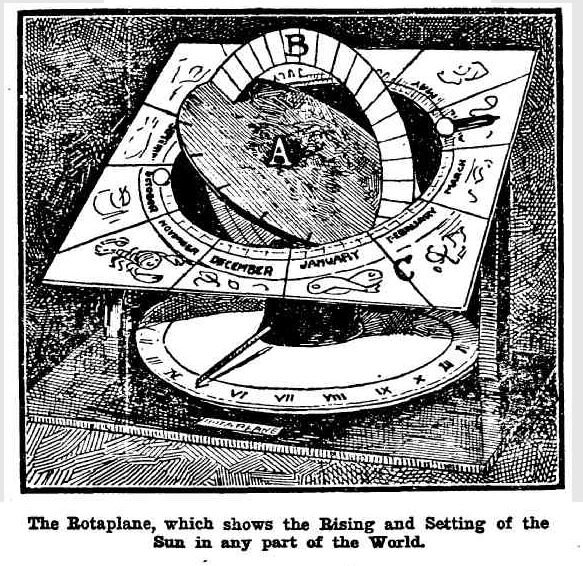nivek
As Above So Below
Following the Sun in Any Part of the World.
A LONDON curator Rev. Cecil Thomas, of Spitalfields Parish Church, has invented an interesting aid to the home or school astronomer.
The rotaplane, as it is called, is intended to demonstrate the apparent movements of the sun and moon. As seen at the premises of the manufacturers, Messrs. James W. Vickers and Co., Finsbury-square buildings (says the "Daily Graphic"), it does "what it is designed to do very" cleverly. Its use is suggested as supplementary to the use of the terrestrial globe.
The globe represents the earth to the student in its true form—as a sphere. The rotaplane represents it as it appears to an observer—as a circular plane. By the aid of the globe one may see how a country or continent passes through the sunlight, according to the season of the year; by the aid of the rotaplane the observer sees how his own landscape, with the familiar objects on the horizon, passes through the sunlight.

How the apparatus works maybe seen by reference to the above photograph. "A" is the plane; its edge or circumference, with the points of the compass indicated on it, represents the observer's horizon.
"B" the semi-circle erected on this plane, represents the meridian; 90 degrees is the observer's zenith. "C," the circular opening on which are printed the days and months of the year, and within which the plane rotates, represents the ecliptic—the sun's path in the heavens. "I>," the dial at the base, shows the hour of the day. The hour is indicated by a pointer, which also serves the purpose of rotating the plane.
The object which covers "April" on "C" is an electric lamp; this represents the sun, and is placed on the day of the year which it is desired to study. For purposes of demonstration, the moon can be represented by a small ball which is placed in the ecliptic in the same manner as the electric light; the ball (of luminous paint) may be seen in the photograph against "October."
The semi-circular plane on the opposite side of "B" to that on which the meridian is shown, carries the plane, indicates its inclination, and represents the lower meridian. This semi-circular plane moves in a circular groove and is secured in any position by a set-screw.
Upon it are marked the degrees of latitude, which are indicated by a pointer. To use the apparatus one merely tilts the plane to the latitude required, elevating the north point, and so adjusting the dial that when the meridian is directed towards the "sun," 12 p.m. shall be under the pointer or hour hand.
A LONDON curator Rev. Cecil Thomas, of Spitalfields Parish Church, has invented an interesting aid to the home or school astronomer.
The rotaplane, as it is called, is intended to demonstrate the apparent movements of the sun and moon. As seen at the premises of the manufacturers, Messrs. James W. Vickers and Co., Finsbury-square buildings (says the "Daily Graphic"), it does "what it is designed to do very" cleverly. Its use is suggested as supplementary to the use of the terrestrial globe.
The globe represents the earth to the student in its true form—as a sphere. The rotaplane represents it as it appears to an observer—as a circular plane. By the aid of the globe one may see how a country or continent passes through the sunlight, according to the season of the year; by the aid of the rotaplane the observer sees how his own landscape, with the familiar objects on the horizon, passes through the sunlight.

How the apparatus works maybe seen by reference to the above photograph. "A" is the plane; its edge or circumference, with the points of the compass indicated on it, represents the observer's horizon.
"B" the semi-circle erected on this plane, represents the meridian; 90 degrees is the observer's zenith. "C," the circular opening on which are printed the days and months of the year, and within which the plane rotates, represents the ecliptic—the sun's path in the heavens. "I>," the dial at the base, shows the hour of the day. The hour is indicated by a pointer, which also serves the purpose of rotating the plane.
The object which covers "April" on "C" is an electric lamp; this represents the sun, and is placed on the day of the year which it is desired to study. For purposes of demonstration, the moon can be represented by a small ball which is placed in the ecliptic in the same manner as the electric light; the ball (of luminous paint) may be seen in the photograph against "October."
The semi-circular plane on the opposite side of "B" to that on which the meridian is shown, carries the plane, indicates its inclination, and represents the lower meridian. This semi-circular plane moves in a circular groove and is secured in any position by a set-screw.
Upon it are marked the degrees of latitude, which are indicated by a pointer. To use the apparatus one merely tilts the plane to the latitude required, elevating the north point, and so adjusting the dial that when the meridian is directed towards the "sun," 12 p.m. shall be under the pointer or hour hand.
